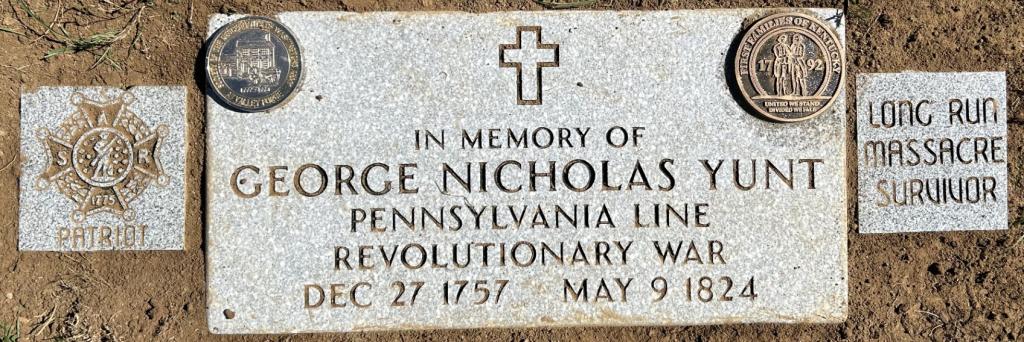George Nicholas YOUNT/YUNT
SAR Patriot #:
P-326511
The following information was assembled from numerous sources and cannot be used directly as proof of Qualifying Service or Lineage.
It is considered a research aid and is intended to assist in locating sources that can be used as proof.
State of Service: PA
Qualifying Service: Private
DAR #: A130488
Birth: 27 Dec 1757 / / PA
Death: 09 May 1824 Brashiers Creek / Shelby / KY
Qualifying Service Description:
1776-1778, he served as a Private in the company of Captain Eli/Elly Meyers/Meirs, commanded by Colonel McCoy of the Continental-, 8th Pennsylvania Line Regiment.
Additional References:
- Revolutionary War Pension: S/W9044
- Collins, Lewis, Collins’ Historical Sketches of Kentucky. History of Kentucky, Kentucky. Louisville: Richard H. Collins, 1877,Volume 1, pg 13
- Willis, George L, History of Shelby County,Kentucky,Shelby County Genealogical and Historical Society,1929, pg 45-47
Spouse: Mary Polly Underwood;
Children: Jacob; Jonathan; Elizabeth; John; Rachel; George;
Members Who Share This Ancestor
| Date Approved | Society | ACN | SAR Member Info | Lineage via Child | View Application Detail | |
|---|---|---|---|---|---|---|
| 1978-10-20 | TX | Unassigned | Albert B Welch (109949) | Jonathan | ||
| 1985-09-27 | MO | 228884 | William Lester Voorhies (126403) | Jacob | ||
| 2023-03-17 | KY | 104967 | Richard Lee Quire (Ret.) (222616) | Jonathan | ||
| 2025-03-28 | KS | 115810 | William Lester Voorhies II (233061) |
Location:
Shelbyville / Shelby / KY / USA
Find A Grave Cemetery #:
Marker Type:
SAR Granite, VA
SAR Grave Dedication Date:
27 Oct 2024
Comments:
Image taken and provided by compatriot Richard Quire (KY) member 222616.
Directions to Cemetery / Gravesite:
The cemetery is adjacent to the church building on the south side, but it is not active. Only three other gravestones are visible.
